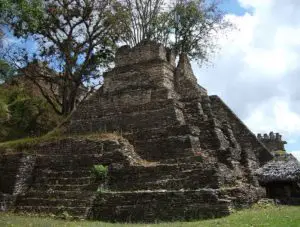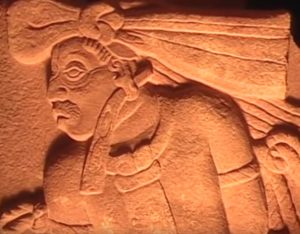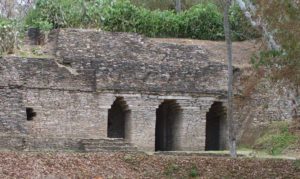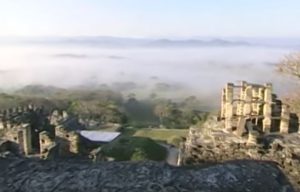Podcast: Play in new window | Download
Subscribe: Apple Podcasts | RSS
 The year was 1638 and the place was somewhere in the jungles of Chiapas. A small group of Mayas from the town of Ocosingo took the young Dominican friar Jacinto Garrido to a special place of the ancestors. They called the abandoned city in the dense forest Tulha or Aharicab Tonila which translated in the local Maya dialects as “house of stone” or “the place where stones are raised to honor time.” The young Dominican would later write in his memoirs some 20 years later of his visit to this massive jungle-shrouded metropolis. He described the enormous pyramid near the core of the ruins, a 7-tiered acropolis which would later be determined to be the tallest pyramid in Mexico. Brother Jacinto wrote in detail of the magnificent art and wall carvings and monuments to former rulers of this place including human statues in plazas. He stated, “They have on their heads something like crowns on their heads that end in a point.” By the time of the arrival of the first formal archaeological expedition to the site in 1808 led by Frenchman Guillaume Dupaix, many of the sculptures and other works of art at Toniná were destroyed. Most of what Garrido saw as the first European at the city in 1638 was not recognizable to Dupaix when he arrived in the early 1800s. A combination of time and local religious ferver had led to the deterioration of the ruins. Later adventurers, such as the famous duo Stephens and Catherwood, in 1840, would note that many of the great works of art had been ritually destroyed by the Christianized Maya. The descendants of the very people who built the place systematically obliterated the art in an apparent frenzy to erase all evidence of a pagan past. The religious zealotry in the individuals responsible for defacing wall carvings and toppling statues was apparently not enough to do much damage to the great pyramid at the center of the site. At over 240 feet in height, the impressive building remains to this day, a testimony to the ingenuity and engineering prowess of the ancient Maya who built this place.
The year was 1638 and the place was somewhere in the jungles of Chiapas. A small group of Mayas from the town of Ocosingo took the young Dominican friar Jacinto Garrido to a special place of the ancestors. They called the abandoned city in the dense forest Tulha or Aharicab Tonila which translated in the local Maya dialects as “house of stone” or “the place where stones are raised to honor time.” The young Dominican would later write in his memoirs some 20 years later of his visit to this massive jungle-shrouded metropolis. He described the enormous pyramid near the core of the ruins, a 7-tiered acropolis which would later be determined to be the tallest pyramid in Mexico. Brother Jacinto wrote in detail of the magnificent art and wall carvings and monuments to former rulers of this place including human statues in plazas. He stated, “They have on their heads something like crowns on their heads that end in a point.” By the time of the arrival of the first formal archaeological expedition to the site in 1808 led by Frenchman Guillaume Dupaix, many of the sculptures and other works of art at Toniná were destroyed. Most of what Garrido saw as the first European at the city in 1638 was not recognizable to Dupaix when he arrived in the early 1800s. A combination of time and local religious ferver had led to the deterioration of the ruins. Later adventurers, such as the famous duo Stephens and Catherwood, in 1840, would note that many of the great works of art had been ritually destroyed by the Christianized Maya. The descendants of the very people who built the place systematically obliterated the art in an apparent frenzy to erase all evidence of a pagan past. The religious zealotry in the individuals responsible for defacing wall carvings and toppling statues was apparently not enough to do much damage to the great pyramid at the center of the site. At over 240 feet in height, the impressive building remains to this day, a testimony to the ingenuity and engineering prowess of the ancient Maya who built this place.
Although not as famous to outsiders as Chichén Itzá, Tikal or Palenque, Toniná had great status among the ancient Maya city-states. From name glyphs found throughout the world of the Maya, Toniná was known as the city of Po or Popo. This is not to be confused with the Maya name for the central Mexican city of Teotihuacán, which was Puh. The city of Toniná started on the road to prominence sometime in the late 400s or early 500s AD. The first verifiable ruler’s name on a monument dates to the year 568. Archaeologists refer to this king as Ruler One and he is symbolized by the hieroglyphs for a jaguar, a bird and a peccary. Researchers deciphering the Maya texts on site believe Ruler One held the throne from 563 to 577 AD. A great statue to this ruler which was broken into three parts was discovered on the 5th level of Toniná’s great pyramid and has since been restored. The first record of the city of Toniná recorded elsewhere is found at the small site of Chinikha about 45 mils to the northeast of the city. In the year 573 the Chinikha people recorded the capture of an important person from Toniná. This 573 date occurred during the early part of  Toniná’s warring period. Ruler One had two successors that have names still debated among the academics, although one is known to have acceded the throne at 8 or 9 years old. Ruler Two, also known as Jaguar Casper, came to power in the year 668. This king built many monuments to commemorate the conflicts Toniná was having with other Maya kingdoms. He commissioned the famous Giant Ahaw Altars which show detailed reliefs of bound and tortured captives, including one depicting the abduction of a foreign princess, one of the few representations of women in ancient Maya art having a war theme. Ruler Two’s reign ended in the year 684 when he was captured by the king of Palenque, one of the main superpowers of the ancient Maya world. Temple 17 at Palenque records the subjugation of the illustrious ruler of Po and gives his date of sacrifice at the hands of the king of Palenque as the year 687. After the capture of the Toniná king by Palenque, Ruler 3 took power of Toniná. He was also known as Serpent Skull, and his 27-year reign was marked by constant conflict with arch-rival Palenque. It was during his rule when Toniná expanded its influence and its civic-ceremonial center began to grow. Serpent Skull inaugurated the city’s great ball court in 699 and dedicated it to the city’s victories against Palenque and its client states. It was during this time that the great pyramid, the dominating acropolis of Toniná, was built out and finer details were added to it. Serpent Skull would be followed by seven other rulers, some well-known to archaeologists and some not-so-well-known, as translations of monuments continue to fill in the elite histories of this important city. Researchers know of major events, which can also be corroborated by inscriptions on monuments in other Maya cities, such as the Toniná’s capture – in the year 711 AD – of Palenque’s king, K’an Joy Chitam the Second, son of the famous King Pacal of Palenque. This occurred during the rule of a Toniná king called Jaguar God, also known as Ruler 4. The most mysterious ruler of Toniná was a queen named Lady K’awil, and all that has yet been discovered about her was that she died in the year 774. By the 800s, the city was in a marked decline and the collapse occurring throughout the Maya world was coming for Toniná. The last known date ever recorded on a monument in the Maya world occurs here, the year 909 AD. Archaeological evidence indicates that the site was probably occupied for another 100 years and was abandoned around 1000 AD, some 600 years before the Dominican friar Jacinto Garrido set eyes on the jungle-encrusted city.
Toniná’s warring period. Ruler One had two successors that have names still debated among the academics, although one is known to have acceded the throne at 8 or 9 years old. Ruler Two, also known as Jaguar Casper, came to power in the year 668. This king built many monuments to commemorate the conflicts Toniná was having with other Maya kingdoms. He commissioned the famous Giant Ahaw Altars which show detailed reliefs of bound and tortured captives, including one depicting the abduction of a foreign princess, one of the few representations of women in ancient Maya art having a war theme. Ruler Two’s reign ended in the year 684 when he was captured by the king of Palenque, one of the main superpowers of the ancient Maya world. Temple 17 at Palenque records the subjugation of the illustrious ruler of Po and gives his date of sacrifice at the hands of the king of Palenque as the year 687. After the capture of the Toniná king by Palenque, Ruler 3 took power of Toniná. He was also known as Serpent Skull, and his 27-year reign was marked by constant conflict with arch-rival Palenque. It was during his rule when Toniná expanded its influence and its civic-ceremonial center began to grow. Serpent Skull inaugurated the city’s great ball court in 699 and dedicated it to the city’s victories against Palenque and its client states. It was during this time that the great pyramid, the dominating acropolis of Toniná, was built out and finer details were added to it. Serpent Skull would be followed by seven other rulers, some well-known to archaeologists and some not-so-well-known, as translations of monuments continue to fill in the elite histories of this important city. Researchers know of major events, which can also be corroborated by inscriptions on monuments in other Maya cities, such as the Toniná’s capture – in the year 711 AD – of Palenque’s king, K’an Joy Chitam the Second, son of the famous King Pacal of Palenque. This occurred during the rule of a Toniná king called Jaguar God, also known as Ruler 4. The most mysterious ruler of Toniná was a queen named Lady K’awil, and all that has yet been discovered about her was that she died in the year 774. By the 800s, the city was in a marked decline and the collapse occurring throughout the Maya world was coming for Toniná. The last known date ever recorded on a monument in the Maya world occurs here, the year 909 AD. Archaeological evidence indicates that the site was probably occupied for another 100 years and was abandoned around 1000 AD, some 600 years before the Dominican friar Jacinto Garrido set eyes on the jungle-encrusted city.
 The great pyramid at Toniná is often referred to as “The Acropolis” because of its massive size and intricate and diverse elements. How or why such a complicated structure was built is still up to debate and no one knows when construction began on the huge monument or when it was finished. It is the tallest pyramid in Mexico and by volume it ranks in the top 5 and thus makes it one of the largest pyramids in the world. This Acropolis rests on a largely man-made pyramidal structure that rises over 70 meters. It includes many temples and public art features worth noting. On the second level of the pyramid is The Palace of the Underworld entered through three vaulted arches on the eastern side. On the pyramid’s fourth level is The Palace of the Frets, noted for its repeating ornamental design of interlaced vertical and horizontal lines. This palace includes a highly decorated throne and an impressive stucco mural featuring feathered serpents and what appears to be a death god. On the east end of the fifth terrace of the pyramid-acropolis is the Frieze of the Dream Lords, one of the finest examples of Classic Maya stucco murals only discovered in 1992. The frieze has stylistic similarities to the mural art of Teotihuacán, the great central Mexican civilization which reached its height in the early days of Toniná. The great pyramid was also decorated with a wide variety of sculptures and murals and was probably once painted red, blue and yellow.
The great pyramid at Toniná is often referred to as “The Acropolis” because of its massive size and intricate and diverse elements. How or why such a complicated structure was built is still up to debate and no one knows when construction began on the huge monument or when it was finished. It is the tallest pyramid in Mexico and by volume it ranks in the top 5 and thus makes it one of the largest pyramids in the world. This Acropolis rests on a largely man-made pyramidal structure that rises over 70 meters. It includes many temples and public art features worth noting. On the second level of the pyramid is The Palace of the Underworld entered through three vaulted arches on the eastern side. On the pyramid’s fourth level is The Palace of the Frets, noted for its repeating ornamental design of interlaced vertical and horizontal lines. This palace includes a highly decorated throne and an impressive stucco mural featuring feathered serpents and what appears to be a death god. On the east end of the fifth terrace of the pyramid-acropolis is the Frieze of the Dream Lords, one of the finest examples of Classic Maya stucco murals only discovered in 1992. The frieze has stylistic similarities to the mural art of Teotihuacán, the great central Mexican civilization which reached its height in the early days of Toniná. The great pyramid was also decorated with a wide variety of sculptures and murals and was probably once painted red, blue and yellow.
It’s not only the refined art and architecture of the pyramid at Toniná which gets the attention of researchers. As one scholar put it:
“Toniná wasn’t simply a brash mountain of carved stone, erected to dominate the landscape and cast its shadow upon the people of the surrounding lands. Although this was a large part of its function, there are a number of highly esoteric features built into the structure.”
Some archaeologists believe that the great pyramid was built to honor the ancient Mesoamerican Calendar and the rituals that surrounded it. The Toniná pyramid has exactly 260 steps which equals the number of days in the Mesoamerican Calendar. The structure has 13 temples which correspond to the day-numbers of the Mayan Calendar. The 13 temples exist on the seven levels of the pyramid. 13 temples, plus 7 levels equals the same number of the basic 20-day cycle of the calendar. In ancient Mexican calendrics, the 13-day numbers cycled against the 20 day names to produce 260 uniquely identified days within the Sacred Calendar, which is also, as previously mentioned, the exact number of steps on the pyramid. Some researchers go further and tie the numbers associated with the acropolis, or great pyramid, with astronomy. Astute Mayan astronomers were incredibly skilled and would have been able to track 7 planets with the naked eye. They  also would have been able to keep close track of the 13 lunar-cycles that the moon completes each year. Some researchers believe that they may have added these numbers together – 7 and 13 – on their 10 fingers and 10 toes and concluded that these were the sacred numbers of the universe. The height of Toniná’s pyramid is also a point of curiosity. The basic unit of measurement in ancient Mexico was often determined by measuring the distance between the fingertip and the heart of the average male citizen. At the central Mexican city of Teotihuacán, for example, the basic measuring unit was 83 centimeters long. This is often called a “Teotihuacán Unit.” Assuming people in Toniná were about the same size as the citizens of Teotihuacán, another interesting numerical revelation appears on this gigantic building. On the Toniná Pyramid, the 7 levels multiplied with its 13 temples equals 91. If one divides the height of the pyramid into 91 equal sections, each one of those 91 units measures 83.5 centimeters, which was about the same basic unit measurement – from the fingertip to the heart – used at Teotihuacán, 83. The pyramid seems to have been designed to mathematical perfection. This synchronistic math makes seasoned researchers and armchair archaeologists alike sit up and take notice. Some believe that the pyramidal structure of Toniná was deeply symbolic of time and may have even been a physical representation of time itself. Indeed, one of the names for the ruined city translated from one of the local Maya dialects is, “The place where stones are raised to honor time.” It must have taken generations of highly skilled craftsman, scientists and priests to complete the great pyramid. It’s a wonder how this complex structure could have been built amidst the city’s constant warfare and the city just going about the business of everyday life. The elite class most probably had been using the calendar encoded into the pyramid to determine its actions against its neighbors and to know when to carry out specific rituals. Some investigators take an extra step and believe that the rise and fall of rulers and city-states were all staged events coinciding with the great calendar systems used at the time, with Divine Lords living the roles they had been born to play. While Maya civilization was extremely structured, perhaps it is going a little too far to suggest that all of life’s events were preordained by the calendar and the cosmos and the elites were mere actors in a predetermined cycle of destiny. The site of Toniná is chock full of yet-uncovered inscriptions and illustrative art that can complete the story of what once happened at this magnificent place. There are most certainly more mysteries to be uncovered.
also would have been able to keep close track of the 13 lunar-cycles that the moon completes each year. Some researchers believe that they may have added these numbers together – 7 and 13 – on their 10 fingers and 10 toes and concluded that these were the sacred numbers of the universe. The height of Toniná’s pyramid is also a point of curiosity. The basic unit of measurement in ancient Mexico was often determined by measuring the distance between the fingertip and the heart of the average male citizen. At the central Mexican city of Teotihuacán, for example, the basic measuring unit was 83 centimeters long. This is often called a “Teotihuacán Unit.” Assuming people in Toniná were about the same size as the citizens of Teotihuacán, another interesting numerical revelation appears on this gigantic building. On the Toniná Pyramid, the 7 levels multiplied with its 13 temples equals 91. If one divides the height of the pyramid into 91 equal sections, each one of those 91 units measures 83.5 centimeters, which was about the same basic unit measurement – from the fingertip to the heart – used at Teotihuacán, 83. The pyramid seems to have been designed to mathematical perfection. This synchronistic math makes seasoned researchers and armchair archaeologists alike sit up and take notice. Some believe that the pyramidal structure of Toniná was deeply symbolic of time and may have even been a physical representation of time itself. Indeed, one of the names for the ruined city translated from one of the local Maya dialects is, “The place where stones are raised to honor time.” It must have taken generations of highly skilled craftsman, scientists and priests to complete the great pyramid. It’s a wonder how this complex structure could have been built amidst the city’s constant warfare and the city just going about the business of everyday life. The elite class most probably had been using the calendar encoded into the pyramid to determine its actions against its neighbors and to know when to carry out specific rituals. Some investigators take an extra step and believe that the rise and fall of rulers and city-states were all staged events coinciding with the great calendar systems used at the time, with Divine Lords living the roles they had been born to play. While Maya civilization was extremely structured, perhaps it is going a little too far to suggest that all of life’s events were preordained by the calendar and the cosmos and the elites were mere actors in a predetermined cycle of destiny. The site of Toniná is chock full of yet-uncovered inscriptions and illustrative art that can complete the story of what once happened at this magnificent place. There are most certainly more mysteries to be uncovered.
REFERENCES
Miller, Mary Ellen. Maya Art and Architecture. New York & London: Thames & Hudson, 1999. Buy the book on Amazon here: https://amzn.to/37lydBk
Mexico’s National Institute of Anthropology and History (INAH) website on Toniná (in Spanish) http://www.inah.gob.mx/es/zonas/29-zona-arqueologica-de-tonina
